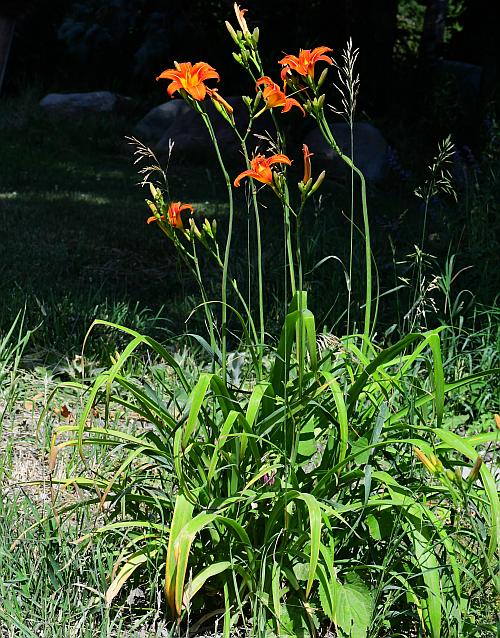Hemerocallis fulva (L.) L.
Orange Day Lily

Introduced
CC = *
CW = 5
MOC = 41
© SRTurner
Hemerocallis fulva (L.) L.Orange Day Lily | |
 |
Introduced CC = * CW = 5 MOC = 41 |
© SRTurner |
|
Family - Liliaceae Habit - Perennial forb, with fleshy stolons and stout, thickened, fleshy rootstocks, the roots often with tuberlike thickenings at the tips. Stems - Aerial stems erect, to 1.5 m, unbranched below the inflorescence, erect, glabrous.
Leaves - Alternate, basal, 50-100 cm long, 1-3 cm wide, linear, entire, somewhat folded or channeled longitudinally, glabrous. Leaves of the upper stem reduced to small bracts.
Inflorescences - Terminal, usually 2-branched panicles, sometimes reduced and appearing as racemes or umbels. Flower stalks 1-15 mm long.
Flowers - Perianth 85-130 mm long, fused into a narrow tube in the lower third, the lobes oblong to elliptic, funnelform, the tips usually arched outward and spreading, orange to brick red, with a lighter midrib on the petal lobes. Petals 3. Sepals 3, slightly smaller than petals. Stamens 6, fused to the top of the perianth tube, the filaments arched and all positioned on one side of the flower. Style 1, parallel to the filaments of the stamens, the stigma capitate. Ovary superior, with 3 locules, each with numerous ovules.
Fruits - Capsules, not maturing in Missouri plants. Flowering - May - August. Habitat - Disturbed streambanks, roadsides, railroads, fields, pastures, old homesites. Extensively cultivated and frequently escaped. Origin - Native to Eurasia. Lookalikes - Broadly, Iris fulva. Other info. - Large displays of this showy plant are commonly seen along rural roadsides. These usually represent deliberate cultivation, since the plants are normally sterile and do not spread far. Under favorable conditions, vegetative spread by means of stolons can result in large clonal colonies. The plant is easily recognized by its large, apparently 6-parted orange flowers. There is passing resemblance to Iris fulva, but the flower morphology is actually quite different. Photographs taken in the Honey Creek Conservation Area, MO., 6-14-03 (DETenaglia); also Riverfront Park, Washington, Franklin County, MO, 6-7-2018, along the Katy Trail near Dutzow, Warren County, MO, 6-30-2019, and near Goodrich, Genesee County, MI, 7-03-2022 (SRTurner). |